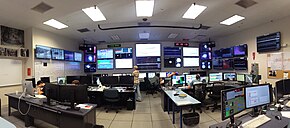 The LIGO Livingston control room as it was during Advanced LIGO's first observing run (O1) | |
| Alternative names | LIGO |
|---|---|
| Location(s) | Hanford Site, Washington and Livingston, Louisiana, US |
| Coordinates | LIGO Hanford Observatory: 46°27′18.52″N 119°24′27.56″W / 46.4551444°N 119.4076556°W LIGO Livingston Observatory: 30°33′46.42″N 90°46′27.27″W / 30.5628944°N 90.7742417°W |
| Organization | LIGO Scientific Collaboration |
| Wavelength | 43 km (7.0 kHz)–10,000 km (30 Hz) |
| Built | 1994–2002 |
| First light | 23 August 2002 |
| Telescope style | gravitational-wave observatory |
| Length | 4,000 m (13,123 ft 4 in) |
| Website | www |
LIGO observatories in the Contiguous United States | |
| | |
The Laser Interferometer Gravitational-Wave Observatory (LIGO) is a large-scale physics experiment and observatory designed to detect cosmic gravitational waves and to develop gravitational-wave observations as an astronomical tool.[1] Two large observatories were built in the United States with the aim of detecting gravitational waves by laser interferometry. These observatories use mirrors spaced four kilometers apart to measure changes in length—over an effective span of 1120 km—of less than one ten-thousandth the charge diameter of a proton.[2]
The initial LIGO observatories were funded by the United States National Science Foundation (NSF) and were conceived, built and are operated by Caltech and MIT.[3][4] They collected data from 2002 to 2010 but no gravitational waves were detected.
The Advanced LIGO Project to enhance the original LIGO detectors began in 2008 and continues to be supported by the NSF, with important contributions from the United Kingdom's Science and Technology Facilities Council, the Max Planck Society of Germany, and the Australian Research Council.[5][6] The improved detectors began operation in 2015. The detection of gravitational waves was reported in 2016 by the LIGO Scientific Collaboration (LSC) and the Virgo Collaboration with the international participation of scientists from several universities and research institutions. Scientists involved in the project and the analysis of the data for gravitational-wave astronomy are organized by the LSC, which includes more than 1000 scientists worldwide,[7][8][9] as well as 440,000 active Einstein@Home users as of December 2016[update].[10]
LIGO is the largest and most ambitious project ever funded by the NSF.[11][12] In 2017, the Nobel Prize in Physics was awarded to Rainer Weiss, Kip Thorne and Barry C. Barish "for decisive contributions to the LIGO detector and the observation of gravitational waves".[13]
Observations are made in "runs". As of January 2022[update], LIGO has made three runs (with one of the runs divided into two "subruns"), and made 90 detections of gravitational waves.[14][15] Maintenance and upgrades of the detectors are made between runs. The first run, O1, which ran from 12 September 2015 to 19 January 2016, made the first three detections, all black hole mergers. The second run, O2, which ran from 30 November 2016 to 25 August 2017, made eight detections: seven black hole mergers and the first neutron star merger.[16] The third run, O3, began on 1 April 2019; it was divided into O3a, from 1 April to 30 September 2019, and O3b, from 1 November 2019[17] until it was suspended on 27 March 2020 due to COVID-19.[18] The O3 run included the first detection of the merger of a neutron star with a black hole.[15]
The gravitational wave observatories LIGO, Virgo in Italy, and KAGRA in Japan are coordinating to continue observations after the COVID-caused stop, and LIGO's O4 observing run started on 24 May 2023.[19][20] LIGO projects a sensitivity goal of 160–190 Mpc for binary neutron star mergers (sensitivities: Virgo 80–115 Mpc, KAGRA greater than 1 Mpc).[21]
- ^ Barish, Barry C.; Weiss, Rainer (October 1999). "LIGO and the Detection of Gravitational Waves". Physics Today. 52 (10): 44. Bibcode:1999PhT....52j..44B. doi:10.1063/1.882861.
- ^ "Facts". LIGO. Archived from the original on 4 July 2017. Retrieved 24 August 2017.
This is equivalent to measuring the distance from Earth to the nearest star to an accuracy smaller than the width of a human hair!
(that is, to Proxima Centauri at 4.0208×1013 km). - ^ "LIGO Lab Caltech MIT". Retrieved 24 June 2016.
- ^ "LIGO MIT". Retrieved 24 June 2016.
- ^ "Major research project to detect gravitational waves is underway". University of Birmingham News. University of Birmingham. Retrieved 28 November 2015.
- ^ Shoemaker, David (2012). "The evolution of Advanced LIGO" (PDF). LIGO Magazine (1): 8.
- ^ "Revolutionary Grassroots Astrophysics Project "Einstein@Home" Goes Live". Retrieved 3 March 2016.
- ^ "LSC/Virgo Census". myLIGO. Retrieved 28 November 2015.
- ^ Cite error: The named reference
Nature_2015_Sept_15was invoked but never defined (see the help page). - ^ "BOINCstats project statistics". Retrieved 14 December 2016.
- ^ Larger physics projects in the United States, such as Fermilab, have traditionally been funded by the Department of Energy.
- ^ "LIGO: The Search for Gravitational Waves". www.nsf.gov. National Science Foundation. Archived from the original on 15 September 2016. Retrieved 3 September 2018.
- ^ "The Nobel Prize in Physics 2017". Nobel Foundation.
- ^ "LSC News".
- ^ a b "LSC News".
- ^ The LIGO Scientific Collaboration; the Virgo Collaboration; Abbott, B. P.; Abbott, R.; Abbott, T. D.; Abraham, S.; Acernese, F.; Ackley, K.; Adams, C.; Adhikari, R. X.; Adya, V. B. (4 September 2019). "GWTC-1: A Gravitational-Wave Transient Catalog of Compact Binary Mergers Observed by LIGO and Virgo during the First and Second Observing Runs". Physical Review X. 9 (3): 031040. arXiv:1811.12907. Bibcode:2019PhRvX...9c1040A. doi:10.1103/PhysRevX.9.031040. ISSN 2160-3308. S2CID 119366083.
- ^ LIGO (1 November 2019). "Welcome to O3b!". @ligo. Retrieved 11 November 2019.
- ^ "LIGO Suspends Third Observing Run (O3)". 26 March 2020. Retrieved 15 July 2020.
- ^ "Gravitational-Wave Observatory Status". Gravitational Wave Open Science Center. 24 May 2023. Retrieved 25 May 2023.
- ^ Castelvecchi, Davide (24 May 2023). "Gravitational-wave detector LIGO is back — and can now spot more colliding black holes than ever". Nature. 618 (7963): 13–14. Bibcode:2023Natur.618...13C. doi:10.1038/d41586-023-01732-4. PMID 37225822. S2CID 258899900.
- ^ "LIGO, VIRGO AND KAGRA OBSERVING RUN PLANS". Retrieved 14 December 2021.
